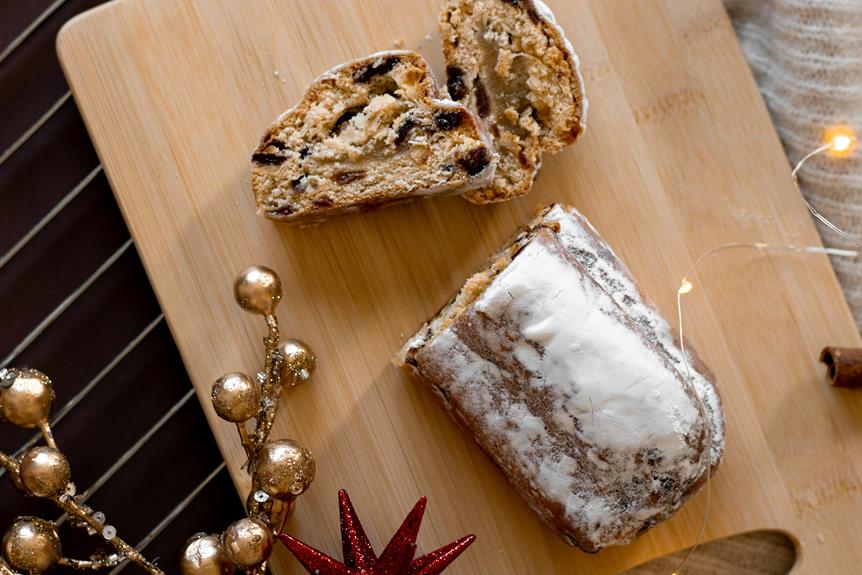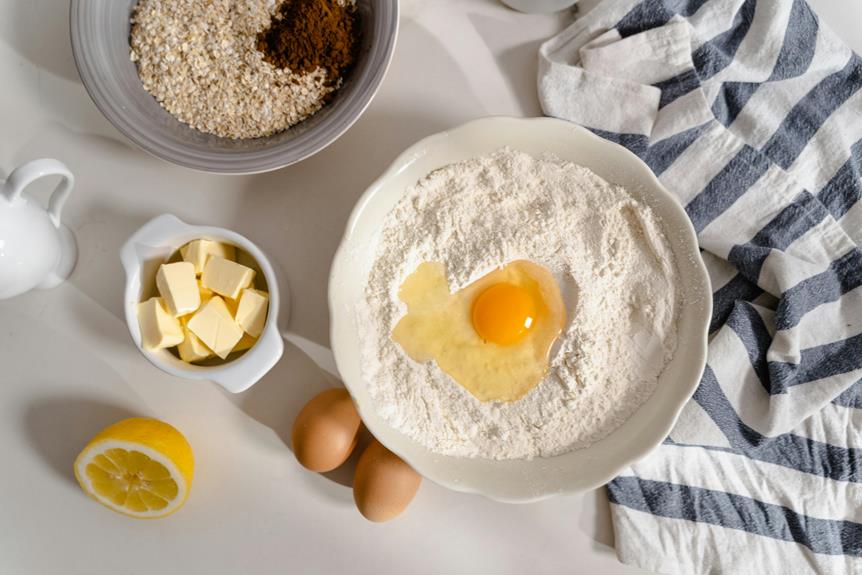You're about to discover the iconic British dessert that's steeped in tradition and festive charm. Christmas pudding, dating back to medieval times, has evolved into a rich, dense, and indulgent treat. With essential ingredients like dried fruits, nuts, and suet, you'll create a dessert that's both symbolic of good luck and prosperity. From preparing the fruit mixture to steaming the pudding to perfection, every step is vital. Follow these time-honored techniques to create a truly unforgettable holiday classic. As you continue, you'll uncover the secrets to making this beloved dessert a staple of your holiday celebrations.
Key Takeaways
- Christmas pudding originated in medieval times as "plum pudding" and evolved into a rich, dense dessert during the Victorian era.
- Essential ingredients include dried fruits, nuts, suet, brandy, eggs, and milk, while necessary equipment includes a large mixing bowl and pudding basin.
- A mix of fruits with varying sweetness, tartness, and texture should be soaked in a liquid for at least 24 hours to rehydrate and absorb flavors.
- The pudding should be steamed for several hours to cook it through and fully set, with the exact time depending on the size of the pudding.
- Christmas pudding can be made weeks or even months in advance and reheated by steaming or microwaving until warm and fluffy.
The History of Christmas Pudding
You've likely indulged in a rich, fruity Christmas pudding at some point, but have you ever wondered where this beloved British tradition originated?
The history of Christmas pudding is a fascinating tale that dates back to medieval times. During the Middle Ages, a dish called 'plum pudding' was served at special occasions, including Christmas.
This sweet, fruit-filled treat was a staple of British cuisine, and its popularity endured for centuries.
As Victorian traditions took hold, Christmas pudding evolved to become a rich, dense, and indulgent dessert.
It was often served with brandy butter, which added an extra layer of flavor and festivity to the dish.
The Victorian era also saw the rise of Christmas pudding as a symbol of good luck and prosperity.
It was customary to make a wish while stirring the pudding mixture, and to add coins or trinkets to the batter for good fortune.
Today, Christmas pudding remains a cherished part of British holiday traditions, with its rich flavors and aromas evoking memories of Christmases past.
Essential Ingredients and Equipment
Essential Ingredients and Equipment
To make a traditional British Christmas pudding, gather the following essential ingredients.
You'll need basic pantry staples like all-purpose flour, brown sugar, and spices, as well as dried fruits, nuts, and suet. Don't forget the essential liquids: brandy, eggs, and milk. Make sure you have these ingredients in the right quantities to guarantee your pudding turns out rich and flavorful.
In addition to the ingredients, you'll need some kitchen essentials and special utensils.
A large mixing bowl, a wooden spoon, and a grinder or food processor will come in handy. You'll also need a pudding basin or a heatproof bowl, a piece of parchment paper, and some string to secure the paper. A steamer or a large pot with a steamer basket is necessary for cooking the pudding. Finally, have some cheesecloth or a clean, thin towel ready to wrap the pudding after it's cooked.
With these ingredients and equipment, you'll be well on your way to creating a delicious, traditional British Christmas pudding.
Preparing the Fruit Mixture
Start by preparing the fruit mixture, which involves combining an assortment of dried fruits, nuts, and spices in a specific ratio to achieve the perfect balance of flavors and textures.
You'll need to select a mix of fruits that complement each other with respect to sweetness, tartness, and texture. A good fruit selection should include a combination of sweet fruits like raisins and currants, tart fruits like cranberries and citrus peel, and nuts like almonds and pecans for added crunch.
When preparing your fruit mixture:
- Soak the fruits: Allow the fruits to soak in a liquid of your choice (such as brandy, rum, or orange juice) for at least 24 hours to rehydrate and absorb the flavors.
- Use the right ratio: Aim for a ratio of 1 part nuts to 2 parts dried fruits to provide a good balance of textures.
- Don't overmix: Gently fold the ingredients together to prevent crushing the fruits or nuts.
Mixing the Batter and Steaming
Now that your fruit mixture is prepared, combine it with flour, suet, and spices to create the batter, making sure to mix everything just until the ingredients come together in a cohesive mass.
Be careful not to overmix, as this can lead to a dense and heavy pudding. Stop mixing as soon as the ingredients are fully incorporated, and you'll be rewarded with a light and fluffy texture.
Once you've mixed the batter, it's time to steam your pudding. You'll need to steam it for several hours to confirm it's cooked through and fully set.
The exact steaming time will depend on the size of your pudding, but as a general rule, you can expect to steam it for around 2-3 hours for a small pudding, and up to 6 hours for a larger one.
Make sure to check on your pudding regularly to avoid overcooking, which can make it dry and crumbly.
The Steaming Process Explained
You'll need a large pot with a steamer basket and a tight-fitting lid to steam your pudding successfully. This setup will allow you to cook your pudding evenly and safely.
When it comes to steaming safety, make sure to check the water level frequently to avoid boiling dry, which can cause the pudding to burn or the pot to warp. Also, never leave the steaming pot unattended, as the steam can cause burns or start a fire.
Use a gentle boil: A gentle boil will help cook the pudding evenly and prevent it from bursting open during steaming.
Steam for the right amount of time: Steam your pudding for 2-3 hours, or until it's cooked through and firm to the touch.
Let it rest: After steaming, let your pudding rest for 10-15 minutes before serving. This will help it retain its shape and make it easier to slice.
Serving and Decorating Ideas
Your beautifully steamed Christmas pudding deserves a grand presentation, so get creative with toppings and garnishes that reflect your personal style.
Consider arranging your pudding on a festive Pudding Platters, adorned with holly sprigs, candy canes, or other holiday-themed decorations. For an extra touch, drizzle with brandy butter or a sweet glaze.
To add some drama to your presentation, why not try adding Fancy Flames to your pudding? Simply pour a small amount of brandy over the pudding and carefully ignite it, allowing the flames to dance across the surface for a few seconds before extinguishing them.
This classic British tradition is sure to impress your guests and add a touch of magic to your holiday gathering.
When it comes to serving, you can't go wrong with a traditional brandy sauce or whipped cream. Alternatively, try serving with a side of sweet or savory biscuits for a delightful contrast in textures.
Whatever your choice, be sure to savor the fruits of your labor and enjoy the oohs and aahs from your delighted guests.
Tips for Making Ahead
By preparing your Christmas pudding ahead of time, you can greatly reduce holiday stress and focus on enjoying the festivities with family and friends. This classic British dessert can be made weeks or even months in advance, allowing you to manage your time more efficiently during the holiday season.
Store your prepared pudding in an airtight container or freezer bag, labeling it with the date and contents. This will help you keep track of how long it's been stored and confirm you use the oldest ones first.
Make your pudding on a weekend or a day off when you have some extra time. This will allow you to focus on other holiday preparations without feeling rushed.
When you're ready to serve, simply thaw your pudding overnight in the fridge or at room temperature for a few hours. Reheat it by steaming or microwaving until warm and fluffy.
Frequently Asked Questions
Can I Make Christmas Pudding in a Slow Cooker Instead of Steaming?
You're wondering if you can ditch the steamer for a slow cooker? Absolutely! Using a Crockpot offers benefits like hands-off cooking convenience, allowing you to prep and forget while still achieving a deliciously moist Christmas pudding.
Can I Use Self-Raising Flour Instead of All-Purpose Flour?
"Are you tempted to substitute self-raising flour for all-purpose flour? You can, but be aware that self-raising flour has a different ratio of flour to baking powder, which might affect the pudding's texture and rise."
How Do I Store Leftover Christmas Pudding?
You'll want to store leftover Christmas pudding in an airtight container, portioning it into individual servings for easy refrigeration. Wrap each pudding portion tightly in plastic wrap or aluminum foil and refrigerate for up to 2 weeks.
Can I Make Christmas Pudding Without Suet or Substitute It?
You can make Christmas pudding without suet by using alternatives like butter, coconut oil, or vegan options like coconut cream or nut butters, which will give your pudding a rich, moist texture and delicious flavor.
Can I Freeze Christmas Pudding After It's Been Cooked?
Wrap yourself in holiday cheer, knowing you can freeze cooked Christmas pudding! Just guarantee freezer safety by wrapping it tightly, and when thawed, the pudding texture will remain rich and velvety, ready to delight your guests.
Conclusion
As you wrap up the steaming process, your kitchen is filled with the warm, comforting aroma of spices and fruit, transporting you to a cozy winter wonderland.
Your traditional British Christmas pudding, a true holiday classic, is now ready to take center stage.
Rich, velvety, and indulgent, it's the perfect crowning glory for your festive feast.
Slice into it, and the sweet, sticky juices will flow like a golden sunrise, bathing your senses in delight.


